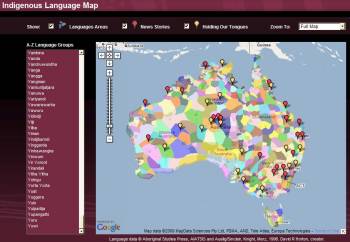 Impressive use of google maps over at the ABC web site.
Impressive use of google maps over at the ABC web site.
Moira and i were discussing this map of indigenous Australian languages.. so i looked to find some copies online while she looked in the book-on-shelf style atlas. Snap! We got our results at the same time.
Since i first viewed the map (large poster print), i’ve loved the way it gives a sense of how geography has shaped cultural and language groupings over many thousands of years. You can almost see the mountains, the desert, the rivers reflected in the language differences over the land.
But as we know there is tragedy behind this beautiful representation:
- The Federation of Aboriginal and Torres Strait Islander Languages (FATSIL) reported that the top end of Australia is among 5 global hotspots for endangered languages.
- Another reference on the Aboriginal languages of Australia – edited by David Nathan – tells me that of 200 Australian indigenous languages less than 20 remain strong.
- Wikipedia claims that there were 350-750 indigenous Australian languages at the end of the 18th century.
 Recently the federal government agreed to give some money toward preserving remaining languages. i wonder if that’s anywhere near enough. (Some ignorance and unpleasantness in the comments on that news story.)
Recently the federal government agreed to give some money toward preserving remaining languages. i wonder if that’s anywhere near enough. (Some ignorance and unpleasantness in the comments on that news story.)
More enlightened discussion of that story over at the University of Sydney Transient language centre, where one of the language centre managers is optimistic about policy development (in the comment section).
In my opinion, the destruction of indigenous language goes hand-in-hand with the destruction of culture. That’s the way it happens all round the world. To have access to power you must speak the language of your oppressors. The Welsh were forbidden to speak their own language. Deaf people taught by the oral method were forced to sit on their hands. Indigenous people were moved to missions and taught the language of the “higher race”.
Of course it’s always done with the best of intentions. Giving people access to a world that excludes them. Rescuing the savages from their primitive culture.